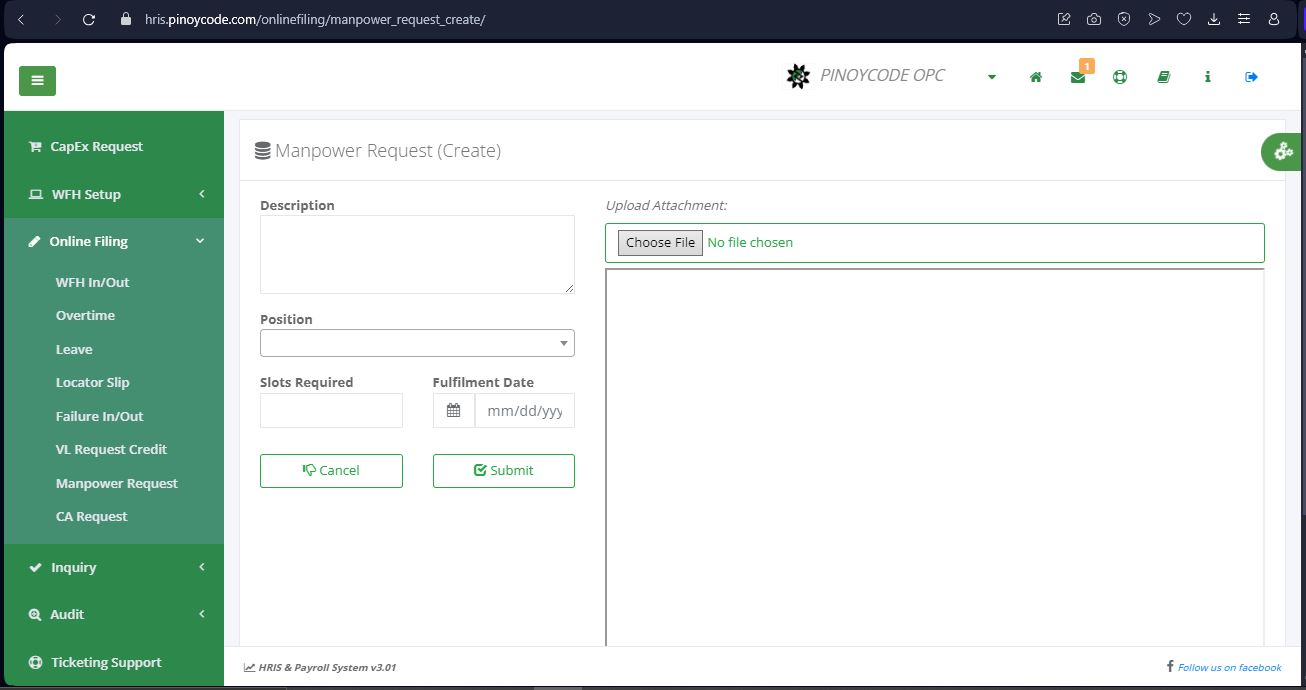Department Additional Manpower Request
A manpower request is a formal process used by departments or teams within an organization to request additional human resources (staff) to meet operational requirements, manage workload increases, or fill vacant positions. This process ensures that the right talent is available to meet business goals and maintain productivity.

Key Element
Identification of Need:
-
The first step in the manpower request process is identifying the need for additional staff. This could arise from factors such as:
- Increased workload or seasonal demand
- Employee turnover (e.g., resignation, retirement, or promotion)
- Project requirements or new initiatives
- Specialized skills needed for particular tasks
- Department heads or managers assess the scope of the work, the skills required, and the expected duration for which the new manpower is needed.
Preparation of the Request:
-
A formal request is prepared, usually in the form of a document or through a digital system. The request typically includes:
- Job title and description
- Required qualifications and experience
- Justification for the need (e.g., increased workload, project deadlines)
- Estimated number of additional staff required
- Budget or compensation considerations (salary, benefits)
- Timeframe for recruitment (immediate, short-term, long-term)
Approval Process:
-
The manpower request is submitted to higher management or HR for approval. The approval process may involve:
- Review by HR for budget compliance, staffing policies, and alignment with organizational objectives.
- Assessment by senior management to ensure that the manpower request aligns with overall business goals.
- In some cases, the request might be evaluated by a budget or finance team to ensure funds are available for the new hires.
Recruitment and Onboarding:
-
Once approved, the recruitment process begins, which could involve:
- Posting job advertisements or sourcing candidates through recruitment agencies.
- Conducting interviews and selecting the right candidates based on the job specifications.
- Completing the necessary administrative steps for onboarding, such as contract preparation, orientation, and training.
Monitoring and Adjustment:
- After the new staff members are hired, the department monitors their performance to ensure they meet the intended goals and objectives.
- If additional manpower is found to be unnecessary or if the needs change, the request may be revised or terminated based on the evolving business context.
Benefits:
- Ensures departments have the necessary resources to meet deadlines, handle workloads, and achieve targets.
- Helps HR and management plan for recruitment needs, preventing understaffing or overstaffing.
- Supports operational efficiency and employee satisfaction by addressing workforce gaps.
Challenges:
- Delays in the approval or recruitment process can lead to understaffing and increased workload for existing employees.
- Budget constraints may limit the ability to fulfill manpower requests, affecting project timelines or department efficiency.
- Inaccurate or poorly defined requests can lead to mismatched hires or unproductive staffing.
Automation and Optimization: Many organizations now use automated HR software to streamline the manpower request process. This allows managers to submit and track requests more efficiently and enables HR departments to prioritize staffing needs based on data-driven insights.
In summary, requesting manpower for departmental needs is a structured process aimed at ensuring that teams have the right resources to fulfill operational tasks and achieve organizational goals. By properly defining and managing these requests, businesses can maintain productivity, meet deadlines, and optimize staffing levels.
ULTRA LOTTO 6/58
- Draw Date: 07/15/2025
- Result: 22-38-36-08-16-41
- Price: Php 223,465,859.20
- Winner: 0
GRAND LOTTO 6/55
- Draw Date: 07/16/2025
- Result: 32-53-20-08-45-54
- Price: Php 29,700,000.00
- Winner: 0
SUPER LOTTO 6/49
- Draw Date: 07/17/2025
- Result: 29-08-04-37-14-02
- Price: Php 29,576,927.20
- Winner: 0
MEGA LOTTO 6/45
- Draw Date: 07/16/2025
- Result: 44-30-12-24-06-35
- Price: Php 21,538,656.00
- Winner: 1
LOTTO 6/42
- Draw Date: 07/17/2025
- Result: 33-31-19-37-21-41
- Price: Php 48,913,755.20
- Winner: 0
6 Digit
- Draw Date: 07/17/2025
- Result: 5-1-4-3-4-2
- Price: Php 2,120,010.36
- Winner: 0
4 Digit
- Draw Date: 07/16/2025
- Result: 0-9-5-2
- Price: Php 52,092.00
- Winner: 16
SWERTRES RESULTS
- Draw Date: 07/18/2025
- 2PM: 5-4-3
- 5PM: 4-5-1
- 9PM:
EZ2 RESULTS
- Draw Date: 07/18/2025
- 2PM: 21-14
- 5PM: 10-10
- 9PM: